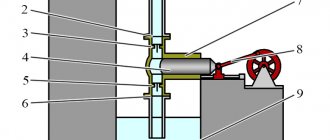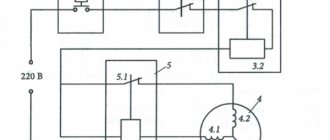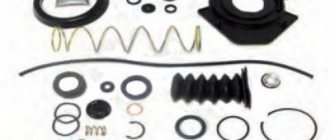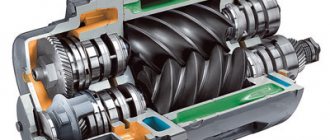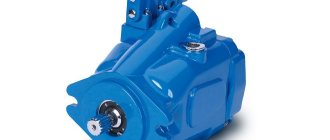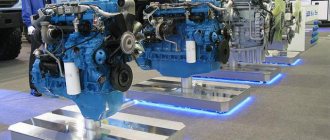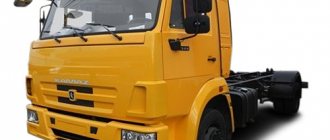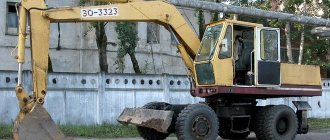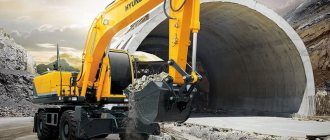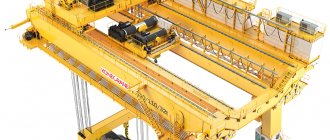How does the main compressor assembly work?
The main unit of piston injection equipment is the compressor itself. In it, in fact, compression of the medium occurs, for which the unit is designed to work. In refrigerator compressors, for example, this is a refrigerant, and in various air blowers it is some kind of gas (most often air). Below and further we will talk about the last type of piston equipment - air compressors.
Main unit of piston injection equipment
The simplest compressor design is single-cylinder. It has the same basic components as an internal combustion engine (ICE). This is a working cylinder, a piston located in it, mounted on a connecting rod, and valves, which are called suction and discharge, in contrast to the intake and exhaust of an internal combustion engine. There is also a crankshaft to which a connecting rod is connected. In some compressors, for example, low-power automobile compressors for inflating tires, instead of a crank-crank piston drive, there is an eccentric piston drive.
However, in an internal combustion engine, the piston drives the crankshaft through a connecting rod. In a compressor it's the other way around. The rotating crankshaft drives the piston through the connecting rod. The latter, moving back and forth, first draws air into the cylinder, and then compresses and pushes it out of it.
Piston compressor device
The first cycle of operation of the compressor occurs when the piston moves in the direction from the cylinder cover in which the valves are located. At the same time, the internal volume of the cylinder in this part (between the walls, the cover with valves and the piston) increases. Due to this, a vacuum occurs that overcomes the stiffness of the suction valve spring and opens it. Air is drawn into the cylinder through it. The discharge valve is tightly closed all this time.
When the piston begins to move towards the valve cover, the air begins to compress as the volume of the cylinder in this part decreases. Under the influence of the pressure created in this case, which exceeds atmospheric pressure, and its own spring, the suction valve closes. When the pressure exceeds the value for which the spring stiffness of the discharge valve is designed, it opens and releases air from the cylinder. The latter comes out under pressure, which is called working pressure. It, as can be seen from the description of the compressor operation, is set by the spring stiffness of the discharge valve.
Advantages and disadvantages
Considering modern technologies for the production of such devices and a typical solution, an example of which is a piston compressor, it is necessary to dwell on all the pros and cons. A piston compressor has the following advantages:
- A simple device determines simple actions when repairing main units. The principle of operation of a piston compressor is simple, so if you handle it carefully and regularly service it, the equipment will last for many years.
- The production of such equipment is a simple process. Its final cost depends on this. A piston compressor is cheaper than screw compressors.
- Different types of such equipment are used in many areas.
- Such mechanisms are not afraid of harsh conditions. They perform their assigned tasks perfectly.
Any technology has disadvantages. This equipment is characterized by increased noise and vibration levels during operation. It is almost impossible to influence them, because they are determined by the design. Compressors are installed in separate rooms.
Another drawback. Compressor equipment requires frequent maintenance; without it, it will not work.
If you need repairs to piston compressors, you will learn more about this on the page.
Coaxial and axial devices
The crankshaft or eccentric drive of the compressor is rotated by the unit's engine - electric or internal combustion (diesel or gasoline). Based on the relative position of the motor and the compressor head, the units are divided into 2 types:
- coaxial - the engine and head are located on the same axis, and their shafts are connected directly;
- axial - the engine and the head are installed parallel to each other, and the shaft of the latter is driven into rotation through a belt drive.
Compressor units, which are required to maintain constant pressure and uniform air flow at their outlet, are equipped with a compressed gas storage device - a receiver. It is a durable, thick-walled steel container. In such units, air from the compressor head is first supplied to the receiver, where it is accumulated, and then used for its intended purpose.
Video: oil-free compressors
In order for a screw compressor to produce compressed air absolutely free of oil, it should not be used to seal the rotors and cool it. That is, oil is not injected into the compression chamber. In order for such a unit to operate successfully and not heat up, increased requirements are placed on the manufacture of screws. The compression ratio is reduced by 3–4 times compared to oil ones.
Oil-free compressors are inferior to oil-based ones in all respects except one – the purity of the compressed air. Therefore, if the buyer does not need absolutely pure compressed gas, it is better to take an oil compressor.
Source
About the different types of piston compressors
Piston units are produced in one-, two- and multi-cylinder types. The last 2 types, according to the arrangement of the cylinders, are divided into V-, W-shaped and in-line. The execution of two- and multi-cylinder compression processes can be single-stage or multi-stage (most often 2-stage). The choice of the required compressor is made based on the intended work with it.
How a 1-cylinder works is described above. To understand the principle of operation of other types, it is enough to consider a 2-cylinder unit. In a single-stage compressor, the cylinders (pistons) are the same size. They work in antiphase, alternately sucking in, compressing, and then displacing air into the discharge line.
The 2-stage unit has cylinders of different sizes. Outside air is sucked in having a larger diameter. It is called the 1st stage cylinder or, in other words, low pressure. In it, the air is compressed to some intermediate value. Then the gas is supplied to an interstage cooler (usually a special copper tube), where it is cooled, and then into a high-pressure cylinder or, in other words, a 2nd stage (with a piston of a smaller diameter). In it, the air is compressed to the maximum operating pressure of the compressor.
The dimensions of both cylinders are selected so that approximately equal compression work is performed in each.
Oil-free compressor
At the moment, our industry is in great need of oil-free compressors, which come in both piston and screw types. In some cases, the presence of oil in the air, even in minimal quantities, is unacceptable. For example, to inflate an oxygen cushion. Or to fill an oxygen tank.
To ensure that a piston compressor is oil-free, the surface of its cylinders is coated with a special compound that allows it to operate without machine oil. The piston is also coated with a special compound. Despite great advances in slip-reducing materials, the continuous operation time of an oil-free reciprocating compressor is limited. In some models 10 - 15 minutes per hour.
Pressure switch and pressure gauge as additional equipment
So that electrical units can operate in automatic mode - turning on and off as needed, a pressure switch (pressure switch) is installed on them. It opens the electrical power supply circuit of the engine when the pressure in the receiver of the maximum operating compressor is reached, and the latter stops pumping air.
As soon as the pressure in the tank drops to the minimum value specified by the manufacturer of the unit, the pressure switch closes the circuit back, starting the electric motor. All compressors are equipped with pressure gauges to monitor the pressure at the outlet of the unit and/or in the receiver. The latter must be equipped with a safety valve to relieve excess air.
Most professional and industrial units are equipped with:
- filters to clean the air from oil, if the compressor is oil-based (with a piston group lubrication system), and moisture;
- valve for draining condensate from the receiver.
Some may have air dryers, a fan to cool the compressor head, and other additional equipment. The more complex the device, the more difficult it can be to repair the compressor.
Purpose and functions
Various types of piston compressors are used to produce compressed air. Therefore, they were in demand in earlier times. They continue to be used today. This technique is used in various fields of activity and in production.
Compressors have a high efficiency. Although the equipment can only produce the appropriate performance at set pressure values (from 1 MPa). Such a limitation is not considered a flaw, because other types of equipment with similar characteristics provide high performance only at the specified pressure values.
Operating principle of a piston compressor
The very first version of the compressor unit was a piston compressor. It has found very wide application and is widely used today, due to its high performance and ease of maintenance. It can be successfully used both in small workshops and in industrial production.
The operating principle and design of piston- type compressors depends directly on the type of compressor installation, and may differ in:
- number of cylinders (one cylinder, two cylinders, three cylinders)
- cylinder arrangement (W-shaped, V-shaped, in-line)
- number of compression stages (single-stage, multi-stage)
All compressors have a basic equipment option, which is inherent in most types of compressor units.
Single cylinder piston compressors are the simplest compressor unit. The composition includes elements: a cylinder, a piston, two valves - one for injection, the other for air suction, which are located in the cylinder cover. During operation of the compressor unit, a connecting rod, directly connected to the rotating crankshaft, transmits limited movements through the compression chamber to the piston. In the process, the volume located between the valves and the bottom of the piston increases, resulting in a vacuum.
Exceeding the resistance of the plate that closes the suction valve, atmospheric air opens it and enters the cylinder through the suction pipe.
During the return action of the piston, the air is compressed and its pressure increases. The valve through which air is forced and also held by the plate is opened by a stream of air that is under high pressure. Next, the compressed air enters the discharge pipe. The compressor unit can be powered by an electric motor or by gasoline or diesel engines.
With this principle of operation of the compressor unit, the most efficient operation is obtained. But there is a disadvantage, which is that the supplied compressed air is uneven and comes with pulsations. To smooth out pulsations, the compressor unit is equipped with a receiver.
In single-stage two-cylinder compressor units, the cylinders operate in antiphase, as a result of which they suck in air alternately. The units are equipped with two cylinders of the same size. Next, the air is compressed to the maximum level and forced into the discharge part of the equipment. Then it goes to the receiver to smooth out the pulsations.
Two-stage two-cylinder compressor units are equipped with cylinders of various sizes. The process of compressing air to the required level occurs in the first stage cylinder. Next, the air enters the interstage cooler to cool to the required level. Then, entering the second stage cylinder, the air is compressed. This allows you to obtain the maximum level of air pressure.
The copper tube provides cooling of the compressed air between the cylinders of the two stages, which allows optimizing the compression process and significantly increasing the efficiency of the entire compressor installation. The dimensions of both cylinders are selected so that the same work is carried out at all stages of air compression.
Two-stage piston compressors allow for a higher level of compressor unit performance compared to single-stage units. The advantages are obvious: a minimum amount of energy is consumed with the same engine power of a single-stage and two-stage compressor unit. The temperature in the cylinders of two-stage units is lower than in single-stage compressors. The performance of two-stage compressor units is typically 20 percent greater than that of their single-stage counterparts.
compressors are distinguished by their simplicity, long service life combined with high equipment efficiency. All this in general has made piston compressors one of the most popular, both in private and industrial use.
Presostat, pressure switch JBS6
Compressor Maintenance
Periodic maintenance and following simple rules, which are indicated in the operating instructions for the device, will significantly increase the service life of the equipment. At the time of purchasing a compressor, you must make sure that you have a passport, a warranty card and a factory inventory of components. Otherwise, the service center may refuse service.
The general recommendations of equipment manufacturers and service center specialists sound like this.
- When starting the unit for the first time, we must check the oil using a dipstick. Select lubricant (technical composition) taking into account the operating instructions. After starting, let the engine run idle for 10-15 minutes.
- The oil is changed to a new one after 500 hours of operation (we keep a record book). After draining the waste, the container is cleared of accumulated dirt.
- Before using the tool, it is necessary to lower the pressure to normal if it is too high.
- The air filter should be cleaned at least once a week. Many manufacturers recommend changing it every quarter, especially when the equipment is actively used.
- At the end of each working day, it is necessary to drain the accumulated water from the receiver.
- At the end of the work, the air is bled off and the equipment is completely de-energized.
- When the compressor is idle for a long time, the platform and moving parts of the air valve must be lubricated.
- Keep the device clean. The entry of dirt into the system is fraught not only with a loss of pressure, but also with failure of the main components of the compressor.
Particular attention should be paid to equipment grounding for all non-current-carrying metal components. In a good half of cases, manufacturers output the corresponding conductor to the plug. All that remains is to ground the outlet itself where the device will be connected.
Design and purpose of a piston compressor
According to the principle of operation, a piston compressor belongs to a volumetric compression machine. In these units, compression is performed by reducing the volume in which the gaseous medium is contained.
The working movement is the stroke of the piston inside the cylinder. The design of a piston compressor determines its purpose. These machines are not designed for 24/7 use. For household devices, the operating cycle is no more than 20 minutes, then rest until the piston cools down.
The semi-pro versions are designed to function in a 50/50 mode. Only industrial modifications are capable of working an eight-hour shift without stopping.
Piston compressor design: main components
Units of this type consist of several main units responsible for certain functions:
The engine is usually electric. Creates a workforce. Gasoline or diesel power plants are also installed on compressors, but this is rare.
Broadcast. Drives the piston group, transferring work from the motor. It can be V-belt or straight.
Cylinder block. The driven part, which directly compresses the air or gas mass.
Receiver. Capacity for storing a supply of compressed air. Installed on almost all models. Often serves as a bed.
The piston compressor components are arranged into a coherent system using instrumentation and automation. Auxiliary devices ensure safety and also allow the unit to operate in automatic mode.
Engine
Broadcast
Cylinder block
In another way, we can say that in the compressor the pistons and crankshaft have swapped roles. In an engine, the piston cup is the driving element, the crankshaft is the driven element. In a compressor, on the contrary, the crank mechanism imparts movement to the piston.
Receiver
A reservoir for compressed air or gas is installed on almost all models of piston compressors. It performs two functions.
The first is that a large volume of air in the container dampens the pressure pulsation that occurs due to the reciprocating movement of the piston.
The second function is to ensure short-term repeated operation.
The compressor fills the receiver and then stops. While the deposited compressed air from the tank is supplied to the consumer, the engine and the cylinder-piston head cool down. Otherwise, the device will overheat and an accident will occur.
Single-stage piston compressor
The number of stages in the compressor mechanism affects the pressure to which the outlet air will be compressed. Conventional single-stage devices are used in a small workshop or at home. They allow you to compress air or gas to no higher than 10 bar. Higher pressure figures can only be obtained by using a multi-stage piston compressor. Single-stage units do an excellent job with light work, and will last a long time if you do not use them more and longer than specified in the instructions. Even if at home you use many pneumatic tools at the same time, then when choosing, you should look towards two-stage devices.
Single-stage piston compressor
Design differences
Design alternatives used in the production of piston compressors:
with belt or coaxial drive
oil-filled and oil-free.
Each design solution is aimed at achieving a specific goal.
Direct transmission
The coaxial drive is designed to reduce the weight and dimensions of the structure. This solution eliminates the need for bulky pulleys, belts and ratchets. Torque is transmitted directly from the engine shaft to the crank mechanism of the cylinder block. The disadvantage of this design is difficult cooling.
The operating mode of direct drive equipment is never more than 1:2, that is, it works for 20 minutes and rests for 40 minutes. Sometimes the ratio is even smaller - up to 1:4. This means continuous operation!
V-belt drive
This is a traditional design that has been used since the first piston compressors. Since then, only minor improvements have been made.
A massive ratchet ensures the overall smooth operation of the cylinder-piston group. This is the first advantage. The ratchet is shaped like a wheel. In modern models, the spokes are made in the form of blades, which create an air flow directed towards the piston head.
Additional cooling is the second plus.
The third advantage is ease of maintenance and repair. Most of the wear and tear is on the belts, which are easy to replace. During operation, you should monitor their tension and tighten if necessary. You do not need to disassemble the compressor to perform these steps.
Oil piston compressor
Such models are available with direct and belt drive. The first is used in reconstruction work on the facade of a building, in the manufacture of furniture or in car repair service centers. Belt-driven piston oil compressors are most often used in tire shops, service stations, and also in construction. They differ from direct drive units in that they can operate continuously for several hours.
Oil piston compressor
Oil models can generally be used for a longer period of time. It's all about using oil, which cools the mechanism, reduces the friction between parts, protects the metal from corrosion, and also seals the gaps between some technological elements. The main disadvantage of oil-based compressor models is the clogging of compressed air with microscopic parts of the oil liquid. However, this can be dealt with if you install a modern air preparation system.
